| Srl | Item |
| 1 |
ID:
036756
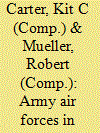

|
|
|
|
|
| Publication |
Washington, Albert F Simpson Historical Research Centre, 1973.
|
| Description |
ix, 991p.Hbk
|
|
|
|
|
|
|
|
|
|
|
|
Copies: C:1/I:0,R:0,Q:0
Circulation
| Accession# | Call# | Current Location | Status | Policy | Location |
| 025421 | 940.544/CAR 025421 | Main | On Shelf | General | |
|
|
|
|
| 2 |
ID:
024089
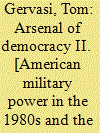

|
|
|
|
|
| Publication |
041598, Grove Press, 1981.
|
| Description |
300p.
|
| Standard Number |
0394176626
|
|
|
|
|
|
|
|
|
|
|
|
Copies: C:1/I:0,R:0,Q:0
Circulation
| Accession# | Call# | Current Location | Status | Policy | Location |
| 020192 | 355.033273/GER 020192 | Main | On Shelf | General | |
|
|
|
|
| 3 |
ID:
105612
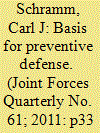

|
|
|
| 4 |
ID:
076152
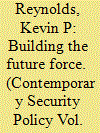

|
|
|
|
|
| Publication |
2006.
|
| Summary/Abstract |
The United States military is in the midst of a major transformation effort, largely conceived around weapons systems procurement. This process of transformation through acquisition will not produce fully operational capabilities for another 15-20 years. But will the capability sets that these weapons represent enable, or will they constrain, the policy options of future national decision-makers? Although national security policy should drive the development of future military capabilities, that is seldom the case, as these problems show. The problem arises largely from three challenges to transformation: the difference in planning horizons between national security and weapons systems or policy lag; problems with the role of the armed forces in weapons systems decision-making; and the Department of Defense's fixation on the narrow theoretical constructs of Network Centric Warfare. These problems are illustrated here by the US Army's dominant contemporary procurement project, the Future Combat System. Overcoming these challenges will require bureaucratic reform throughout the government's national security community, including the National Security Council, Department of Defense and the Congressional Armed Services committees.
|
|
|
|
|
|
|
|
|
|
|
|
|
|
|
|
| 5 |
ID:
089765


|
|
|
|
|
| Publication |
2009.
|
| Summary/Abstract |
As everyone braces for a bloody summer, the new US administration has shaken up its top military command in Afghanistan. But is the continued focus on the military intervention still too predominant.
|
|
|
|
|
|
|
|
|
|
|
|
|
|
|
|
| 6 |
ID:
095581
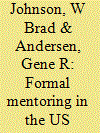

|
|
|
| 7 |
ID:
104474
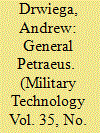

|
|
|
| 8 |
ID:
089719
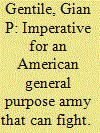

|
|
|
| 9 |
ID:
080682
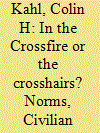

|
|
|
|
|
| Publication |
2007.
|
| Summary/Abstract |
The belief that U.S. forces regularly violate the norm of noncombatant immunity (i.e., the notion that civilians should not be targeted or disproportionately harmed during hostilities) has been widely held since the outset of the Iraq War. Yet the evidence suggests that the U.S. military has done a better job of respecting noncombatant immunity in Iraq than is commonly thought. It also suggests that compliance has improved over time as the military has adjusted its behavior in response to real and perceived violations of the norm. This behavior is best explained by the internalization of noncombatant immunity within the U.S. military's organizational culture, especially since the Vietnam War. Contemporary U.S. military culture is characterized by an "annihilation-restraint paradox": a commitment to the use of overwhelming but lawful force. The restraint portion of this paradox explains relatively high levels of U.S. adherence with the norm of noncombatant immunity in Iraq, while the tension between annihilation and restraint helps to account for instances of noncompliance and for why Iraqi civilian casualties from U.S. operations, although low by historical standards, have still probably been higher than was militarily necessary or inevitable.
|
|
|
|
|
|
|
|
|
|
|
|
|
|
|
|
| 10 |
ID:
080768
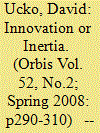

|
|
|
|
|
| Publication |
2008.
|
| Summary/Abstract |
Following its encounter with insurgent violence in Iraq, the U.S. Department of Defense (DoD) has sought to improve the U.S. military's ability to conduct counterinsurgency. This effort suggests a potential turning-point in the history of the U.S. military, which has traditionally devoted its attention and resources to "high-intensity" or "conventional" combat. Given this institutional culture, what are now the prospects of the U.S. military 'learning counterinsurgency'? In many ways, the ongoing reorientation is promising and targeted, informed directly by the U.S. campaign in Iraq. At the same time, Pentagon priorities still reveal a remarkable resistance to change, and this in spite of the radically altered strategic environment of the War on Terror. Given this intransigence - and the eventual fall-out from the troubled Iraq campaign - the ongoing learning of counterinsurgency might very well fail to produce the type of deep-rooted change needed to truly transform the U.S. military
|
|
|
|
|
|
|
|
|
|
|
|
|
|
|
|
| 11 |
ID:
105614
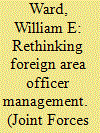

|
|
|
| 12 |
ID:
089716


|
|
|
|
|
| Publication |
2009.
|
| Summary/Abstract |
Our military is in reasonably good shape today, but it is working very hard and the level of individual sacrifice among soldiers and Marines, in particular, is very high. Were it not for the distinct likelihood of a major reduction in combined deployments to Iraq and Afghanistan by 2010, we would need urgent responses to the situation now. And if those missions go less well, or less quickly, than now hoped-or if, heaven forbid, another war breaks out in the meantime-additional measures will be required
|
|
|
|
|
|
|
|
|
|
|
|
|
|
|
|